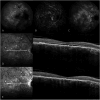PREDNISOLONE EYE DROPS AS A POTENTIAL TREATMENT IN NONNEOVASCULAR PACHYCHOROID-RELATED DISEASES
- PMID: 39047197
- PMCID: PMC11280446
- DOI: 10.1097/IAE.0000000000004109
PREDNISOLONE EYE DROPS AS A POTENTIAL TREATMENT IN NONNEOVASCULAR PACHYCHOROID-RELATED DISEASES
Abstract
Purpose: To investigate the functional and structural outcomes after treatment with prednisolone eye drops in the following pachychoroid-related diseases: chronic central serous chorioretinopathy, pachychoroid pigment epitheliopathy, and peripapillary pachychoroid syndrome.
Methods: In this retrospective study, 54 eyes of 48 patients with pachychoroid-related disease were treated with prednisolone acetate 1% eye drops 3 times a day. Change in macular volume and retinal central subfield thickness on optical coherence tomography was measured. In addition, the foveal or complete resolution of fluid and the change in visual acuity were studied.
Results: The follow-up visit was at a mean of 41.2 ± 14.5 days. In the 44 eyes with chronic central serous chorioretinopathy, a significant reduction in retinal central subfield thickness ( P < 0.001) and macular volume ( P < 0.001) was observed. Foveal intra- or subretinal fluid resolved completely in 22% of the eyes. In the 8 peripapillary pachychoroid syndrome eyes, a reduction in the nasal retinal thickness was observed ( P = 0.025). One of the 2 pachychoroid pigment epitheliopathy eyes showed structural improvement. No significant change in visual acuity was observed in any of the pachychoroid spectrum diseases.
Conclusion: In patients with chronic central serous chorioretinopathy, peripapillary pachychoroid syndrome, and pachychoroid pigment epitheliopathy, anatomical improvement was observed after therapy with prednisolone eye drops. Visual acuity did not change significantly.
Copyright © 2024 The Author(s). Published by Wolters Kluwer Health, Inc. on behalf of the Opthalmic Communications Society, Inc.
Conflict of interest statement
None of the authors has any financial/conflicting interests to disclose.
Figures



References
-
- Siedlecki J, Schworm B, Priglinger SG. The pachychoroid disease spectrum-and the need for a uniform classification system. Ophthalmol Retina 2019;3:1013–1015. - PubMed
-
- Daruich A, Matet A, Dirani A, et al. . Central serous chorioretinopathy: recent findings and new physiopathology hypothesis. Prog Retin Eye Res 2015;48:82–118. - PubMed
-
- van Rijssen TJ, van Dijk EHC, Yzer S, et al. . Central serous chorioretinopathy: towards an evidence-based treatment guideline. Prog Retin Eye Res 2019;73:100770. - PubMed
-
- van Rijssen TJ, van Dijk EHC, Tsonaka R, et al. . Half-dose photodynamic therapy versus eplerenone in chronic central serous chorioretinopathy (SPECTRA): a randomized controlled trial. Am J Ophthalmol 2022;233:101–110. - PubMed
MeSH terms
Substances
Grants and funding
LinkOut - more resources
Full Text Sources
Medical

